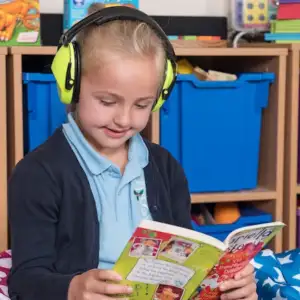Dive into the topic of teacher resilience and work/life balance, in collaboration with our expert podcast guest Dr Steph Ainsworth. Learnings, tips, resource recommendations and more, all included.
Here at TTS, we recently had the privilege of hosting 4 podcast episodes with Dr Steph Ainsworth (Series 5, Episodes 5 – 8), education researcher and educator, to talk all things teacher resilience. Throughout the episodes, they delve into the topic of what it means to be a resilient educator, covering ways to build resilience. They also discuss practical ways you can reduce workload, instead focusing on doing things that impact children the most.
In this blog, we’ll share highlights from the episodes, key things you can put into practice, and recommended resources to help you on your way.
Steph’s episodes are also CPD accredited. If you want to take your learning further, you can complete the equivalent of 1 hour of CPD training after listening. And it’s completely free too.
Episode Highlights
Introduction to Resilience
The conversation underscores the idea that it’s normal for people to have ups and downs; it’s all about giving them the skills to handle it. Whether it’s helping with prioritisation of tasks, removing unnecessary work, or setting clear boundaries – resilience is all about putting these various strategies into place.
Creating a Resilient Environment
They emphasise the importance of a resilient environment, and how being resilient is actually a proactive process. Steph provides insights into using the ‘ACT’ model, having a higher awareness of your feelings and thoughts, and trying alternatives.
Collaborative Solutions
Resilience can be boosted by working on solutions collaboratively as a team. Whether it’s leadership giving recognition to staff, conducting regular staff check-in meetings, or honing emotional intelligence within a team – working together is a vital part of building resilience and at the forefront of discussions throughout the episodes.

Policy and Teacher Resilience
Alistair and Steph also look at the broader policy context of what we can do to help teacher resilience. They discuss the idea of a more flexible curriculum, where teachers have more autonomy within their role. Adopting a child-centered approach is also broached.
Building a Culture of Resilience
They wrap up the topic by emphasising the importance of a culture of resilience, and reinforcing how to build resilience on an individual level through self-compassion and having access to the right resources.
Key Things to put into Practice
Resilience in educators could be defined as those who have the capacity to thrive in difficult circumstances, are skilled in behaviour management, able to empathise with challenging situations, able to restrain negative emotions and focus on the positive, experience a sense of pride and fulfilment and increased commitment to their school and profession.
Self-regulation strategies help educators cope with stress, prevent burnout, and maintain a healthy work-life balance which all then have a positive effect on one’s resilience, wellbeing and ability to cope.
Use a proactive approach ‘The ACT Model’ to support with regulation and understanding one’s emotions:
- A - A is for awareness, being aware of how you feel.
- C – C is for checking, checking your thoughts and feelings as to why you may feel the way you do.
- T – T is for trying, trying an alternative and reframing your thoughts and actions depending on your regulation after being aware and then checking.
Communication within a setting or school is vital, you could encourage communication within the team by:
- Anonymous wellbeing survey.
- Establish an open environment.
- Ensure regular team discussion opportunities such as team meetings are put in place.
- Create a suggestion box.
- Celebrate successes together.
A focus on team relationships and open conversations encouraging vulnerability, providing support and encouraging a culture of resilience.
Resources We’d Recommend
Our in-house expert, Adam Marycz, suggests related resources to help you in your own Early Years setting. All available on the TTS website.
Supporting children to regulate is key in providing a calming environment for both children and educators with a focus on regulation and resilience. Therefore the top resource I would recommend is our set of sensory resources to calm and relax children, fostering self-regulation.
This set offers daily sensory regulating activities that support children in staying calm, focused, and regulated. Designed to support children with varied sensory needs, this set is key for fostering self-regulation and emotional management. Including weighted items, tactile materials, and visual aids, it provides enriched sensory experiences essential for over-sensitive or under-sensitive children, promoting a calm learning environment. Accompanied by teachers’ notes for easy integration into daily routines, the set aims to enhance emotional regulation and self-regulation skills. This proactive approach not only creates a conducive learning atmosphere but also supports children in developing coping and regulation strategies.

Calming Kittens offers young children in early years and KS1 a toolkit to understand and manage their emotions. Through engaging strategies, children learn to calm themselves and gain better emotional self-control. The activity cards assist practitioners, teachers and parents in discussing emotions with children.
Designed with young learners in mind, these compact cat figures offer an engaging way for children to explore their feelings. Each colour-coded kitten represents a specific calming activity that aids in teaching children about their emotions and provides methods for effectively dealing with them. Activities range from controlled breathing to singing, chanting, and physical exercise, helpful in teaching self-regulation and emotional control. Furthermore, these activities stimulate the release of oxytocin, enhancing the child’s overall well-being.
This set is beneficial for both individual and group settings, making it a valuable resource for developing coping strategies and emotional understanding from an early age. Activity cards included facilitate conversations about feelings and emotions, making this toolkit pivotal for emotional literacy.

Our vibrant weighted lap buddy, complete with a supplementary weighted blanket, delivers tailored deep pressure input, catering to individual needs either in tandem or separately. This lap buddy’s vibration mode introduces numerous therapeutic benefits across all age groups, including children with or without disabilities or sensory processing disorders.
The calming weighted lap buddy that utilises gentle vibration for soothing, tactile sensory support. Featuring a soothing vibration mechanism and a weighted blanket, they provide deep pressure input for calming effects.
For an under-sensitive child, it delivers essential sensory feedback to help soothe and regulate, while offering oversensitive children a method to gradually increase tactile tolerance. Its benefits within sensory processing disorder management are immensely valuable. The buddy’s designed feature vibrates gently twice when its back is stroked, with an option to disable vibration ensuring adaptability to various sensory preferences.

Get your CPD Certificate
The topic of Teacher Resilience and Work/Life Balance is a critical one for practitioners to understand. That’s why our episodes with Steph are CPD accredited. Simply watch or listen to the 4 episodes, and complete your free CPD assessment.


